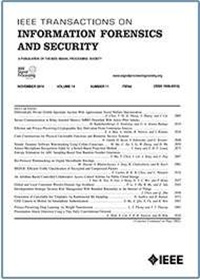正则化零强制预编码的ris辅助安全通信
IF 8
1区 计算机科学
Q1 COMPUTER SCIENCE, THEORY & METHODS
IEEE Transactions on Information Forensics and Security
Pub Date : 2025-06-02
DOI:10.1109/TIFS.2025.3575624
引用次数: 0
摘要
可重构智能表面(RISs)在增强无线系统物理层安全性方面已被证明是有效的,并提出了双时标设计来解决信道估计和相移控制方面的挑战。然而,现有的基于最大比率传输(MRT)的预编码设计在减少信息泄漏方面效果不理想。为此,本文考虑了具有正则化零强制(RZF)和零强制(ZF)预编码的ris辅助多输入单输出(MISO)安全通信的性能分析和双时间尺度设计,这在文献中是没有的。主要的挑战来自于两跳信道和预编码矩阵的逆结构。利用随机矩阵理论,我们首先通过推导遍历保密和率(ESSR)的封闭表达式来评估所考虑系统的基本极限。然后,我们确定了RZF预编码器的最优正则化因子,并评估了高信噪比下独立和同分布(i.i.d)信道的ESSR。结果表明,当RIS的可重构单元数量远远大于发射天线和用户数量时,两跳信道的ESSR接近单跳信道的ESSR。在性能分析的基础上,提出了一种双时间尺度算法,通过交替优化RZF的正则化因子和RIS的相移来最大化ESSR。仿真结果验证了理论分析的准确性和算法的有效性。本文章由计算机程序翻译,如有差异,请以英文原文为准。
RIS-Aided Secure Communications With Regularized Zero-Forcing Precoding
Reconfigurable intelligent surfaces (RISs) have been shown effective in strengthening the physical layer security of wireless systems, and the two-timescale design was proposed to tackle the challenges in channel estimation and phase-shift control. However, existing maximum ratio transmission (MRT) based precoding design is not efficient in mitigating information leakage. To this end, this paper considers the performance analysis and two-timescale design for RIS-aided multiple-input single-output (MISO) secure communications with regularized zero-forcing (RZF) and zero-forcing (ZF) precoding, which is not available in the literature. The major challenges come from the two-hop channel and the inverse structure in the precoding matrix. By utilizing random matrix theory, we first evaluate the fundamental limits of the considered system by deriving a closed-form expression for the ergodic secrecy sum rate (ESSR). Then, we determine the optimal regularization factor of the RZF precoder and evaluate the ESSR over independent and identically distributed (i.i.d.) channels in the high SNR regime. The results indicate that when the number of reconfigurable elements at the RIS is overwhelmingly larger than that of transmit antennas and users, the ESSR of the two-hop channel approaches that of the single-hop channel. Based on the performance analysis, we propose a two-timescale algorithm to maximize the ESSR by optimizing the regularization factor of RZF and the phase shifts of the RIS alternatively. Simulation results validate the accuracy of the theoretical analysis and the effectiveness of the proposed algorithm.
求助全文
通过发布文献求助,成功后即可免费获取论文全文。
去求助
来源期刊

IEEE Transactions on Information Forensics and Security
工程技术-工程:电子与电气
CiteScore
14.40
自引率
7.40%
发文量
234
审稿时长
6.5 months
期刊介绍:
The IEEE Transactions on Information Forensics and Security covers the sciences, technologies, and applications relating to information forensics, information security, biometrics, surveillance and systems applications that incorporate these features
 求助内容:
求助内容: 应助结果提醒方式:
应助结果提醒方式:


